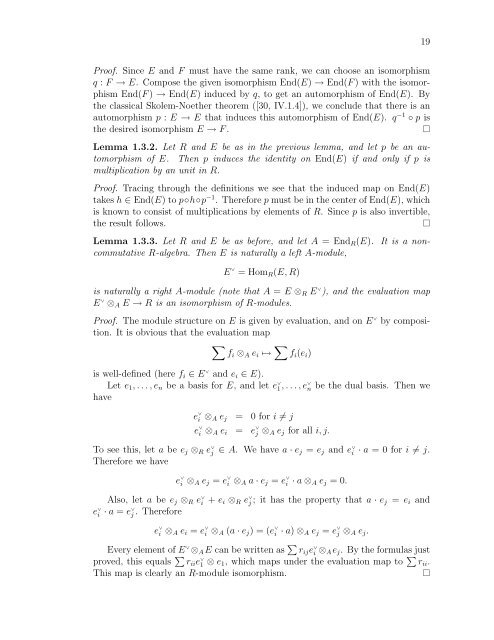derived categories of twisted sheaves on calabi-yau manifolds
derived categories of twisted sheaves on calabi-yau manifolds
derived categories of twisted sheaves on calabi-yau manifolds
Create successful ePaper yourself
Turn your PDF publications into a flip-book with our unique Google optimized e-Paper software.
Pro<str<strong>on</strong>g>of</str<strong>on</strong>g>. Since E and F must have the same rank, we can choose an isomorphism<br />
q : F → E. Compose the given isomorphism End(E) → End(F ) with the isomorphism<br />
End(F ) → End(E) induced by q, to get an automorphism <str<strong>on</strong>g>of</str<strong>on</strong>g> End(E). By<br />
the classical Skolem-Noether theorem ([30, IV.1.4]), we c<strong>on</strong>clude that there is an<br />
automorphism p : E → E that induces this automorphism <str<strong>on</strong>g>of</str<strong>on</strong>g> End(E). q −1 ◦ p is<br />
the desired isomorphism E → F .<br />
Lemma 1.3.2. Let R and E be as in the previous lemma, and let p be an automorphism<br />
<str<strong>on</strong>g>of</str<strong>on</strong>g> E. Then p induces the identity <strong>on</strong> End(E) if and <strong>on</strong>ly if p is<br />
multiplicati<strong>on</strong> by an unit in R.<br />
Pro<str<strong>on</strong>g>of</str<strong>on</strong>g>. Tracing through the definiti<strong>on</strong>s we see that the induced map <strong>on</strong> End(E)<br />
takes h ∈ End(E) to p◦h◦p −1 . Therefore p must be in the center <str<strong>on</strong>g>of</str<strong>on</strong>g> End(E), which<br />
is known to c<strong>on</strong>sist <str<strong>on</strong>g>of</str<strong>on</strong>g> multiplicati<strong>on</strong>s by elements <str<strong>on</strong>g>of</str<strong>on</strong>g> R. Since p is also invertible,<br />
the result follows.<br />
Lemma 1.3.3. Let R and E be as before, and let A = EndR(E). It is a n<strong>on</strong>commutative<br />
R-algebra. Then E is naturally a left A-module,<br />
E ∨ = HomR(E, R)<br />
is naturally a right A-module (note that A = E ⊗R E ∨ ), and the evaluati<strong>on</strong> map<br />
E ∨ ⊗A E → R is an isomorphism <str<strong>on</strong>g>of</str<strong>on</strong>g> R-modules.<br />
Pro<str<strong>on</strong>g>of</str<strong>on</strong>g>. The module structure <strong>on</strong> E is given by evaluati<strong>on</strong>, and <strong>on</strong> E ∨ by compositi<strong>on</strong>.<br />
It is obvious that the evaluati<strong>on</strong> map<br />
fi ⊗A ei ↦→ fi(ei)<br />
is well-defined (here fi ∈ E∨ and ei ∈ E).<br />
Let e1, . . . , en be a basis for E, and let e∨ 1, . . . , e∨ n be the dual basis. Then we<br />
have<br />
e ∨<br />
i ⊗A ej = 0 for i = j<br />
e ∨<br />
i ⊗A ei = e ∨<br />
j ⊗A ej for all i, j.<br />
To see this, let a be ej ⊗R e ∨<br />
j ∈ A. We have a · ej = ej and e ∨<br />
i · a = 0 for i = j.<br />
Therefore we have<br />
e ∨<br />
i ⊗A ej = e ∨<br />
i ⊗A a · ej = e ∨<br />
i · a ⊗A ej = 0.<br />
Also, let a be ej ⊗R e∨ i + ei ⊗R e∨ j ; it has the property that a · ej = ei and<br />
e∨ i · a = e∨ j . Therefore<br />
e ∨<br />
i ⊗A ei = e ∨<br />
i ⊗A (a · ej) = (e ∨<br />
i · a) ⊗A ej = e ∨<br />
j ⊗A ej.<br />
Every element <str<strong>on</strong>g>of</str<strong>on</strong>g> E∨ ⊗A E can be written as rije∨ i ⊗A ej. By the formulas just<br />
proved, this equals riie∨ 1 ⊗ e1, which maps under the evaluati<strong>on</strong> map to rii.<br />
This map is clearly an R-module isomorphism.<br />
19
















